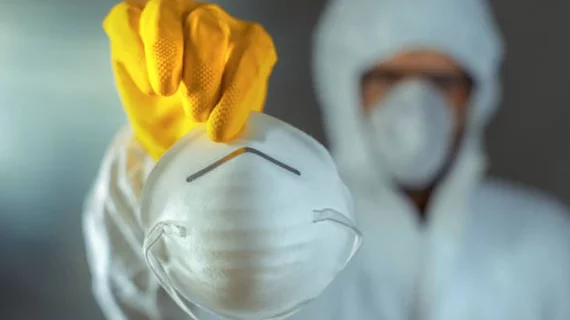N95 masks are a scarce resource across the U.S., as imaging and other specialties compete with hoarders and colleagues in other nations. However, Canadian experts have devised a protocol that may greatly extend the useful life of this key clinical tool.
The supply shortage has prompted drastic actions, with several imaging societies imploring the president for help, and the feds recently confiscating thousands of items from one price gouger. With prices sky-high on the resale market, hospitals have also experienced N95 thefts, which prompted outrage on social media over the weekend.
Clinicians with the University of Manitoba may have devised some relief. Their new sterilization protocol would allow practice employees to use these masks 10 times, according to their preliminary findings, which have not yet been peer reviewed.
“At the start of the pandemic, it was clear we were going to be facing dramatically heavy demands for the N95s,” lead author Anand Kumar, MD, a UM researcher and critical-care physician at Health Sciences Centre Winnipeg, said in a statement. “Our team wanted to explore how different brands and models of N95s responded to standard hospital sterilization technologies in an attempt to identify safe options for their reuse in the event of supply shortages.”
For the yet-to-be-published study, university experts worked in tandem with Canada’s National Microbiology Laboratory. They tested four cleaning methods on four different masks—including ethylene oxide gassing, ionized hydrogen peroxide fogging, and vaporized hydrogen peroxide treatment.
“Our results demonstrate that the assessed decontamination methods were highly effective in sterilizing all four contaminated N95 models mask types. No viable virus was found on any intentionally contaminated mask following any of the decontamination procedures,” added Kumar.
The team reported that two of the sterilization methods showed zero loss of filter function following several cleanings. Kumar expressed particular excitement about the results from autoclaving, a cleaning method that isn’t widely available in North America.
You can read the full pre-review analysis here.
Personal protective equipment has been a hot topic in imaging in recent weeks. The Centers for Disease Control and Prevention recently updated its guidance on PPE for providers, while the feds work to send items to coronavirus hot spots around the country.
Numerous stakeholder groups have sent letters to national leaders, asking for help with the situation. One of the latest pleas came on April 3 from more than 200 groups, including the American heart and lung associations.
“In the midst of this shortage, providers have been forced to resort to potentially dangerous tactics, such as splitting ventilators between two different individuals or reusing masks, that exacerbate the risk for everyone involved, including patients,” the groups wrote Friday, asking the administration to “act immediately” to end such shortfalls.

